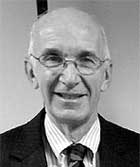| 【特別寄稿】 |
「正論大賞」を受賞して
Thoughts on Receiving the Seiron Taisho
|
特別顧問・ジェームス E.アワー日米研究センター代表取締役所長
ヴァンダービルト大学名誉教授 ジェームス E.アワー
James E. Auer
Special Advisor, Japan Forum for Strategic Studies
President and Director of the James E. Auer U.S.-Japan Center
Emeritus Professor of Vanderbilt University
|
 この度、「正論大賞」を受賞したことを受けて、産経新聞社より感想を求められました。日本のマスコミの中で、日米同盟に対して最も理解のある産経新聞社において、私は既に20年以上も「正論」欄にコラムを執筆するという栄誉をいただいて参りました。 この度、「正論大賞」を受賞したことを受けて、産経新聞社より感想を求められました。日本のマスコミの中で、日米同盟に対して最も理解のある産経新聞社において、私は既に20年以上も「正論」欄にコラムを執筆するという栄誉をいただいて参りました。
冷戦終結直後の1992年、ハーバード大学のサミュエル・ハンチントン教授が『文明の衝突』という有名なスピーチを行い、1996年に同名の書籍として出版されました。著書の中でハンチントン教授は、未来の戦争は、第二次大戦や、冷戦時代における核兵器を装備した二つの超大国による対立などとは異質なものになるであろうと予想しました。過去の戦争は、経済問題や思想の対立などによって引き起こされましたが、未来の武力闘争は、それぞれが根本的に異なり、また平和裡には共存し得ないであろう「八つの文明」において発生する、二つ乃至それ以上の文明間の衝突によって引き起こされるであろう、というものです。
ハンチントン教授は、そんな「八つの文明」の中の二つに日本文化と西洋文化を挙げました。勿論、確かに日本とアメリカは、1941年から45年まで、4年近くも戦いました。しかしその後の両国は、戦争をしていた期間よりも遥かに長い友好関係と文化交流を実現してきたのであり、この事実はハンチントン教授の理論とは合致しません。
日米両国の最初の接触は、1853年にアメリカ大統領の使節として、アメリカ海軍のペリー提督が日本を訪問したことに遡ります。その後の1860年、最初の遣米使節団が、徳川幕府が設立した日本海軍による初の海外ミッションとして、オランダ製の軍艦「咸臨丸」によってアメリカに派遣されました。
昨秋、「正論大賞」を受賞したと知らされた後、私は太平洋戦争終結後に日本の海上自衛隊或いはアメリカ海軍が関係する重要な10の出来事を思い出しました。そして私が選んだこれらの出来事は、いずれもハンチントン教授の理論の不正確さを示唆するものとなっています。
--------------------------------------------------------------------------------------------------------------------------------------------------------
I was asked for my thoughts upon being named to receive the Seiron Taisho by the Sankei Shimbun. Because it is one of the most supportive of the Japan-U.S. alliance of the Japanese mass media, I have been honored to write for Sankeiʼs Seironcolumn for more than two dozen years.
Shortly after the end of the Cold War in 1992, Harvard Professor Samuel Huntington gave a major speech which in 1996 became a book, The Clash of Civilizations. In his speech and in his book, Professor Huntington argued that, unlike past wars such as the two world wars and the nuclear standoff between two global superpowers during the Cold War, future wars were likely to be different. Instead of being fought over economic or ideological issues as past wars have been, future armed conflicts were likely to be the result of clashes between two or more of eight civilizations which are so fundamentally different that they are unlikely to be able to coexist peacefully.
Professor Huntington listed Japanese and Western culture as two of the eight different civilizations. And, of course, while it is true that Japan and the United States clashed bitterly from 1941-1945, that nearly four years of war was preceded and followed by much longer periods of friendship and cultural interchange between Japan and America which argue against the Huntington thesis.
The first connection between the two nations began with the visit of U.S. Navy Commodore Perry to Japan on a mission for the president of the United States in 1853; and the first Japanese Embassy to the United States was carried by a Dutch built corvette, the Kanrin Maru, on the first overseas mission of the Japanese Navy established by the Tokugawa Shogunate in 1860.
After learning of my selection for the Seiron Taisho I tried to recall ten important events related to the Japan Maritime Self-Defense Force and/or the U.S. Navy since the end of the Pacific War. In other words I chose ten events which would have been unlikely to have come about if the Huntington thesis were correct.
|
続きをご覧になりたい方は...
|
|